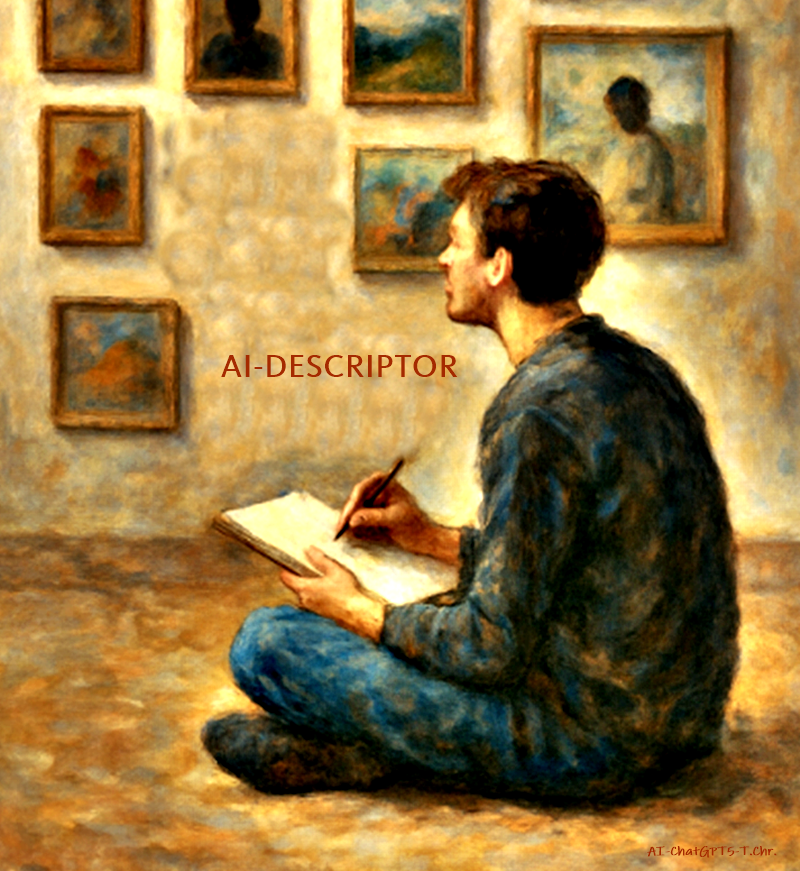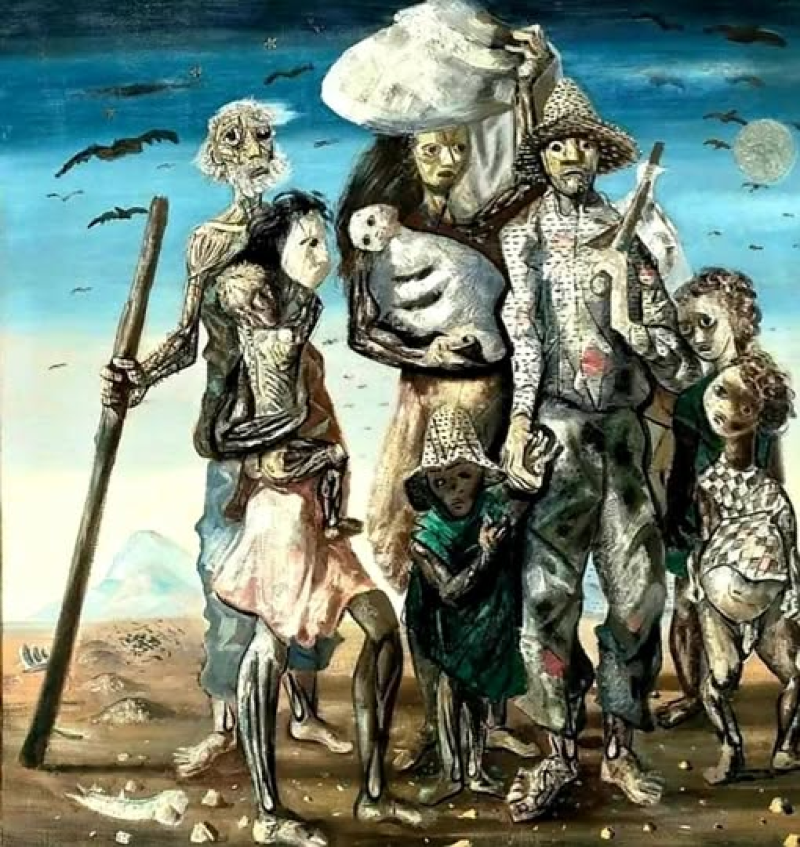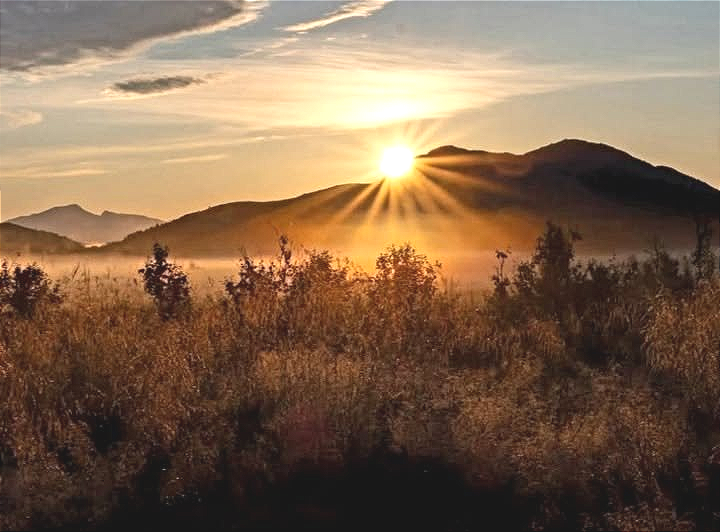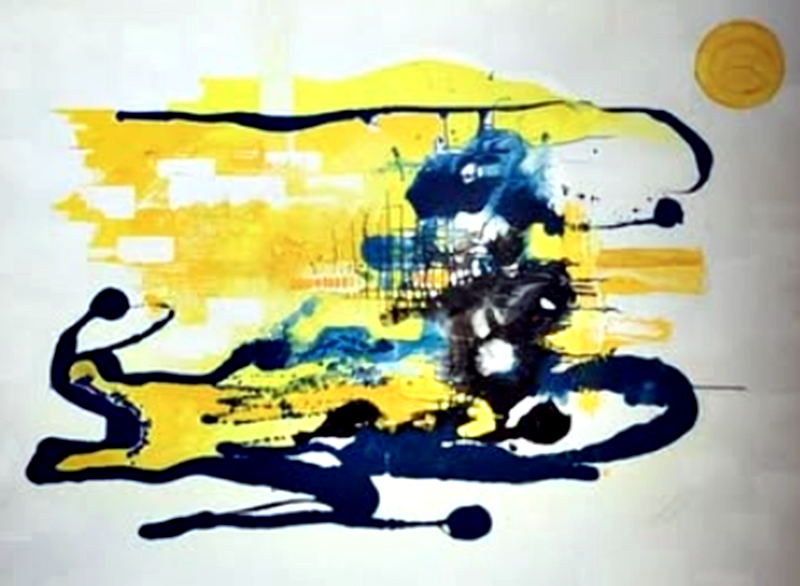AI PHOTO ENTERPRETATION

By AI-ChatGPT5-T.Chr.-Human Synthesis- 01 September 2025
HAUNTING AND EVOCATIVEI

A group of emaciated figures—men, women, and children—walking through a barren, desolate landscape. Their bodies are skeletal, their skin clings to bone, and their expressions (though stylized and almost mask-like) convey exhaustion, suffering, and endurance. The mother clutches a lifeless or weak child, while another holds a stick to support himself. Their clothes are torn, patched, and barely cover them. Above, black birds circle under a stark sky, perhaps vultures, symbols of death and decay.
The artist has chosen exaggerated, distorted forms: angular limbs, hollow eyes, cracked feet. These amplify the sense of famine, displacement, and survival against impossible odds. The figures look like both humans and ghosts—caught between life and death.What I feel:Desperation and endurance: The figures seem to be moving forward, no matter how broken they are. There’s resilience amidst suffering.Universality of suffering: They don’t appear as individuals but as archetypes—anywhere in the world where famine, war, or forced migration exists.
A silent cry: The muted colors and the stark contrasts make this feel like a scream that has no sound, a pain that has been numbed by repetition.It’s a work that confronts the viewer with the brutality of hunger, poverty, and displacement. But in their togetherness—the family clinging to each other—there is also the faintest thread of solidarity and humanity.
CHANGE OF DAY

The sun does not ask permission to rise; it comes, steady and unbroken, spilling light upon the sleeping earth. Each dawn is a reminder that nothing is final—not even night. The mountain receives the first fire of the day without resistance, its dark slopes transformed not by effort but by acceptance.
The mist lifts gently, as though even the air must learn to let go. In this awakening, the world whispers a lesson: renewal is not loud, it is patient. Darkness yields not in defeat but in grace, stepping aside for what must come.
The grasses glow, the sky opens, and everything breathes in unison—an ancient rhythm reminding us that beginnings are given freely, again and again. A sunrise is never the same, yet always familiar, teaching that change is not an end but the quiet turning of the eternal wheel.
THE STILLNESS

In the hush of the clearing, where mist clings low to the earth, a moose stands like a guardian of the forest. Its dark silhouette rises strong and steady against the pale veil of morning light, antlers curved like ancient branches reaching into the air.
Around it, the pines breathe in silence, their needles whispering secrets only the wind can hear. There is a sense of stillness here, as if time itself has paused—just long enough for the soul to meet the wild.
The moose does not pose, nor perform; it simply exists, majestic in its quiet strength, a fleeting glimpse of the untamed world that endures beyond us.
FASCINATION AND LOSS

This painting immediately gives off the impression of something dreamlike, layered between consciousness and memory. It blends sharp objects—a clock, a goblet-like vessel, fragmented figures—with an almost fluid, melting background that feels unstable, as if time and matter themselves are dissolving.
The clock is striking: its warped, leaning form recalls the impossibility of keeping time steady. Time here isn’t linear or mechanical; it’s soft, pliable, maybe even suffocating. The distortion suggests that the artist sees time not as a fixed rhythm but as an overwhelming tide, eroding certainty.
The purple and golden tones set a contrast—purple evokes mystery, melancholy, the unconscious; gold recalls light, memory, and fragile permanence. Together they whisper of the human struggle between decay and endurance, between oblivion and the desire for meaning.
The figures—or impressions of figures—appear trapped or hidden in the vertical drips, like souls caught behind a veil. They feel anonymous, perhaps intentionally so, representing humanity as a shadow within a vast machinery of time. The cocktail-like glass, small and white, stands almost absurdly in the middle: a symbol of fleeting pleasure against the immensity of transience.
Philosophically, this painting speaks of impermanence. It reflects an artist who feels time pressing down, who sees reality as unstable, fragile, and prone to dissolve into abstraction. But at the same time, the artist tries to hold onto fragments—faces, symbols, daily objects—like anchors in a sea of flux.
The feeling of the artist here is conflicted: fascination with the beauty of transience, yet also a quiet despair at the inevitability of loss.
The Canvas of Inner Turmoil

At first glance, the painting presents itself as a dialogue between light and darkness, between order and disorder. Yet on closer study, it becomes clear that what is shown is not the world outside, but the storm within—the restless domain of the self. The work is less landscape than mindscape, a mirror of what it means to be human when confronted with the weight of one’s own contradictions.
The yellow forms in the background suggest structure, stability, and even the optimism of daylight. They are the masks we wear and the systems we build to reassure ourselves that life is intelligible and under control. But across this framework, deep strokes of blue and black spread like violent currents, drowning the order beneath. These are the uncontrollable forces of doubt, fear, grief, and desire—emotions that defy reason’s tidy boundaries. They arrive not politely, but with splashes, stains, and eruptions.
Two faint human figures emerge in the composition. One kneels, as if in supplication or surrender. The other stretches across the bottom of the canvas, burdened, almost crushed by the weight of unseen forces. Together, they embody the postures of inner struggle: the spirit bowed in resignation, the body exhausted by invisible battles. In them we see our own fragility, our tendency to bend under pressures we cannot fully name.
And then there is the sun. Remote, solitary, and unblemished, it floats at the corner of the work—an emblem of clarity, serenity, perhaps even salvation. Yet it remains unreachable. The distance between the turmoil of the canvas and the stillness of the sun is the distance between the human condition and the peace we seek. The artist places it deliberately out of reach, suggesting not hopelessness, but the bittersweet awareness that tranquility may forever elude our grasp while we live.
This painting, therefore, is not an external commentary but an intimate confession. It tells us that to be human is to live with disorder within. Our days are painted with yellow patterns of purpose and order, yet beneath them flow the dark rivers of everything we cannot control. We oscillate between kneeling in despair and reaching for light, yet the turmoil never fully resolves.
The philosophical statement that emerges is stark but honest: peace is not the absence of turmoil, but the acceptance of its presence. In the interplay of chaos and order, the human self takes shape. And perhaps, in acknowledging the storm within, we come closer to touching the distant sun, not as something to conquer, but as something to guide us.
